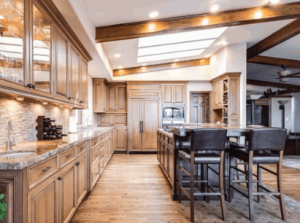
Why Are LEDs Energy Efficient
- Interior Design
- May 10, 2024
Have you ever wondered what makes LEDs so energy efficient compared to traditional lighting options?
We will explore how LEDs work, what sets them apart in terms of energy efficiency, and how they stack up against incandescent, fluorescent, and halogen bulbs.
Discover the benefits of using LEDs, from lower energy bills to reduced environmental impact, and learn how you can easily incorporate them into your home or business.
Let’s shed some light on the world of LEDs!

What Are LEDs?
Contents
LEDs, or Light Emitting Diodes, are semiconductor devices that emit light when an electric current passes through them. They are known for their high energy efficiency, durability, and ability to produce various colors of light.
LEDs operate on the principle of electroluminescence, a process in which the semiconductor material emits light when electrons recombine with electron holes within the device. This method results in the conversion of electrical energy directly into light, making LEDs much more energy-efficient than traditional lighting options. The semiconductor properties of LEDs also give them enhanced durability and a longer lifespan compared to incandescent or fluorescent lights.
Dig deeper: How To Install LED Recessed Lighting Retrofit

How Do LEDs Work?
LEDs work based on the principle of electroluminescence in semiconductors. When an electric current is applied, electrons recombine with electron holes within the device, releasing energy in the form of photons, which results in the emission of light.
In a semiconductor material, such as gallium arsenide or silicon, the movement of electrons creates a flow of electric charge. This movement generates energy in the form of light as the electrons transition between energy levels. The structure of the semiconductor allows this process to occur efficiently, leading to the production of light. The current flow and the properties of the semiconductor heavily influence the color and intensity of the light emitted by the LED.

What Makes LEDs Energy Efficient?
LEDs are highly energy-efficient due to their low heat emission, high luminous efficiency, and ability to convert electrical energy into optical energy efficiently. This results in higher lumens per watt and superior radiant efficiency.
LEDs stand out as a preferred lighting choice not just because of their energy efficiency, but also due to their long lifespan and durability. Compared to traditional lighting sources, LEDs emit very little heat, which means less wasted energy and decreased electricity consumption. Their high luminous efficacy ensures that they produce more visible light per unit of power input, translating into higher brightness levels with the same energy usage.
In terms of energy conversion, LEDs are far more efficient at converting electricity into light instead of heat when compared to incandescent or fluorescent bulbs. This efficiency results in lower operating costs and reduced energy waste. Their radiant efficiency plays a crucial role in minimizing energy loss during light production, further enhancing their overall energy-saving capabilities.
Directional Lighting
Directional lighting is a key feature of LEDs, allowing them to emit light in a specific direction efficiently.
The evolution of LED technology has significantly improved the ability to achieve sharper beam angles and reduce light spillage. This is particularly beneficial in architectural lighting, retail displays, and task lighting where precision is essential.
Low Heat Emission
LEDs exhibit low heat emission due to their efficient heat dissipation mechanisms and the use of advanced semiconductor materials like Gallium Nitride (GaN) in GaN LEDs. This results in reduced energy wastage and enhanced longevity of the LED devices.
Effective heat dissipation in LEDs is crucial not only for improving their operational efficiency but also for ensuring their reliability and performance over time. GaN, a key semiconductor material used in GaN LEDs, plays a significant role in managing the heat generated during operation, thus contributing to the overall thermal management of the device.
By minimizing heat emission, LEDs can operate at lower temperatures, which not only enhances their energy efficiency but also extends their lifespan. The integration of advanced heat dissipation techniques further enhances the thermal properties of LEDs, making them ideal for a wide range of applications where heat management is critical.
Long Lifespan
One of the notable advantages of LEDs is their long lifespan, attributed to factors like efficient heat management and the use of phosphors such as YAG: Ce phosphor for light conversion. This results in prolonged operational durability and reduced maintenance costs.
LEDs typically have a lifespan of up to 50,000 hours or more, far surpassing traditional lighting options. Efficient heat management plays a crucial role in enhancing this longevity by preventing overheating, which can degrade the components. The YAG: Ce phosphor used in LEDs helps in converting the blue light emitted by LEDs into a broad-spectrum white light, contributing to their overall efficiency and longevity.
No Mercury Content
Unlike traditional lighting sources like CFLs, LEDs do not contain mercury, making them environmentally friendly and safer to use.
LEDs, also known as Light Emitting Diodes, are a popular choice for many due to their mercury-free composition, which sets them apart from other types of lighting. This mercury-free feature not only ensures a safer option but also plays a significant role in reducing the overall environmental impact. By opting for LEDs, consumers actively support sustainable practices and contribute to a more eco-conscious approach to lighting solutions. The shift towards LED technology aligns with global efforts towards a greener future and highlights the importance of considering the environmental repercussions of everyday choices.

How Do LEDs Compare To Traditional Lighting?
When compared to traditional lighting sources such as incandescent bulbs and CFLs, LEDs offer superior energy efficiency, cost savings, and longer lifespan. The transition to LEDs results in reduced electricity consumption and maintenance expenses, making them a cost-efficient lighting solution in the long run.
LEDs are known for their exceptional energy efficiency, converting a higher percentage of energy into light rather than heat, unlike incandescent bulbs which waste a significant amount of energy in heat production. This conversion efficiency not only reduces electricity bills but also contributes to energy conservation.
LEDs have a longer lifespan, typically lasting up to 25 times longer than traditional incandescent bulbs. This extended lifespan not only reduces the frequency of replacements but also minimizes the associated costs.
Incandescent Bulbs
Incandescent bulbs are known for their inefficiency in converting electrical energy into light, as they emit a significant amount of heat rather than visible light. This outdated technology results in higher energy consumption and shorter lifespans compared to LEDs.
Due to the high heat production, incandescent lighting is not only wasteful in terms of energy but also poses safety hazards, especially in enclosed fixtures where heat build-up can be dangerous. On the other hand, LEDs are extremely energy-efficient, converting a higher percentage of electrical energy into visible light while generating minimal heat. This translates to lower electricity bills and longer-lasting bulbs, making LEDs a more sustainable and cost-effective lighting option.

Fluorescent Bulbs
Fluorescent bulbs offer better luminous efficacy than incandescent bulbs, but they still fall short of the color rendering capabilities and energy efficiency of LEDs.
Despite the improvements in fluorescent technology, LEDs have quickly overtaken them in terms of overall performance. LED lights not only excel in providing brighter illumination, but they also boast impressive color accuracy, thanks to their high color rendering index (CRI). This means that objects illuminated by LEDs appear more vibrant and true to their actual colors, making them ideal for tasks that require precise color matching.

Halogen Bulbs
Halogen bulbs are known for their high radiant efficiency and immediate full brightness, but they consume more power and have lower lumens per watt compared to LEDs.
The energy-saving benefits and superior luminous output of LEDs make them a more cost-effective lighting solution. LEDs are renowned for their exceptional efficiency in converting electricity into visible light, making them incredibly energy-efficient. On the other hand, the radiant efficiency of halogen bulbs may be high, but their power consumption is significantly higher.

What Are The Benefits Of Using LEDs?
The benefits of using LEDs include lower energy bills due to their high efficiency, reduced environmental impact through energy conservation, and improved quality of light with options for customizable color temperatures and superior brightness.
LEDs stand out as a cost-effective lighting solution for both residential and commercial settings. One of the significant advantages is the long lifespan of LEDs, lasting up to 25 times longer than traditional incandescent bulbs. This longevity not only reduces replacement costs but also minimizes maintenance expenses, making LEDs a smart investment in the long run.
LED lights consume significantly less energy than conventional light sources, translating into substantial savings on electricity bills. The efficiency of LEDs is unmatched, with up to 80% energy savings compared to incandescent bulbs, contributing to a more sustainable environment by reducing overall energy consumption.
Lower Energy Bills
LEDs contribute to lower energy bills by efficiently converting electrical energy into light output, reducing electricity consumption and operational costs over time. The energy-saving properties of LEDs make them a cost-effective lighting choice for homes and businesses.
LEDs have a significantly higher luminous efficiency compared to traditional incandescent bulbs, leading to greater energy savings in the long run. This efficiency not only benefits the environment by reducing electricity usage but also translates into substantial cost reductions for consumers. The long lifespan of LEDs minimizes the need for frequent replacements, further enhancing their cost-effectiveness. As a result, switching to LEDs is not only a smart environmental choice but also a savvy financial investment for individuals and businesses alike.
Reduced Environmental Impact
LEDs play a significant role in reducing environmental impact by minimizing energy consumption and eliminating hazardous materials like mercury. The ability to customize light colors efficiently further enhances their eco-friendly nature and sustainability.
LEDs are celebrated for their impressive energy efficiency, as they require substantially less electricity compared to traditional incandescent bulbs. This translates to lower energy consumption, which directly reduces the carbon footprint and energy expenses. The absence of mercury in LED lights eliminates the risk of harmful substances entering the environment, ensuring a cleaner and safer planet.
Better Quality Of Light
LEDs offer better quality of light compared to traditional bulbs, with options for customizable colors and precise color rendering capabilities. The ability to achieve various color temperatures and brightness levels makes LEDs a preferred choice for enhancing the visual ambiance in different settings.
In terms of color options, LEDs stand out due to their versatility. They come in a wide range of hues, from warm yellows to cool blues, allowing users to create the perfect lighting scheme for any occasion. In terms of color rendering, LEDs excel at accurately displaying colors as they would appear in natural daylight, making them ideal for tasks that require color accuracy, such as art and design work. The brightness control offered by LEDs allows users to fine-tune the intensity of the light to suit their specific needs, whether it’s creating a cozy atmosphere or illuminating a workspace with bright, clear light.

How Can You Incorporate LEDs Into Your Home Or Business?
You can incorporate LEDs into your home or business by replacing traditional light bulbs with LED equivalents, installing LED fixtures for specific lighting needs, and utilizing LEDs for outdoor lighting applications to enhance visibility and energy efficiency.
In terms of bulb replacements, make sure to choose LED bulbs that are compatible with your existing fixtures and offer the desired brightness level and color temperature. Consider installing smart LED bulbs that can be controlled remotely through your smartphone or voice assistants for added convenience.
For fixture installations, opt for integrated LED fixtures that provide a sleek and modern look while offering versatile lighting options. Consider recessed LED lights for ambient lighting, LED track lighting for customizable illumination, and LED strip lights for accentuating architectural features.
When implementing outdoor lighting solutions, use weather-resistant LED fixtures to illuminate pathways, highlight landscaping features, and enhance security. Solar-powered LED lights are a sustainable choice for outdoor spaces that receive ample sunlight, reducing energy costs while still providing adequate illumination during the evening hours.

Replacing Light Bulbs
An effective way to incorporate LEDs is by replacing traditional light bulbs with energy-efficient LED alternatives. This simple conversion can lead to immediate energy savings and improved lighting quality, showcasing the benefits of LED technology.
LED bulbs consume significantly less energy than incandescent or CFL bulbs, making them a sustainable choice for environmentally conscious consumers.
The technological advancements in LED lighting have resulted in longer lifespans, with some LEDs lasting up to 25,000 hours or more, reducing the frequency of bulb replacements.
LEDs produce light in a more focused manner, reducing light pollution and creating a brighter, more evenly distributed illumination in the desired space.
Installing LED Fixtures
Installing LED fixtures allows for customized lighting solutions tailored to specific requirements in homes or businesses. These modern lighting technologies offer energy savings, longevity, and flexibility in lighting design, making them ideal for diverse applications.
LED fixtures are highly efficient due to their ability to convert a high percentage of energy into light rather than heat. This efficiency not only contributes to lower energy consumption but also translates into cost savings for the user. The longevity of LED technology ensures that these fixtures have a much longer lifespan compared to traditional lighting options, reducing the frequency of replacements and maintenance costs.
The flexibility of LED fixtures in terms of color temperature, dimming capabilities, and directional lighting provides users with the versatility to create various ambiance and lighting effects to suit different needs and moods. By incorporating advanced technologies such as smart lighting controls, users can easily customize and control their lighting settings remotely, enhancing convenience and overall user experience.
Using LEDs For Outdoor Lighting
Utilizing LEDs for outdoor lighting applications enhances visibility, safety, and energy efficiency. The use of dimmer circuits with outdoor LEDs allows for adjustable lighting levels based on environmental conditions and specific lighting requirements.
LEDs are known for their long lifespan, which significantly reduces maintenance costs and ensures a reliable lighting source for outdoor areas. These lights also produce less heat, making them ideal for use in various weather conditions without overheating. LEDs are available in a wide range of colors, allowing for creative and customizable lighting solutions to enhance the aesthetic appeal of outdoor spaces.






